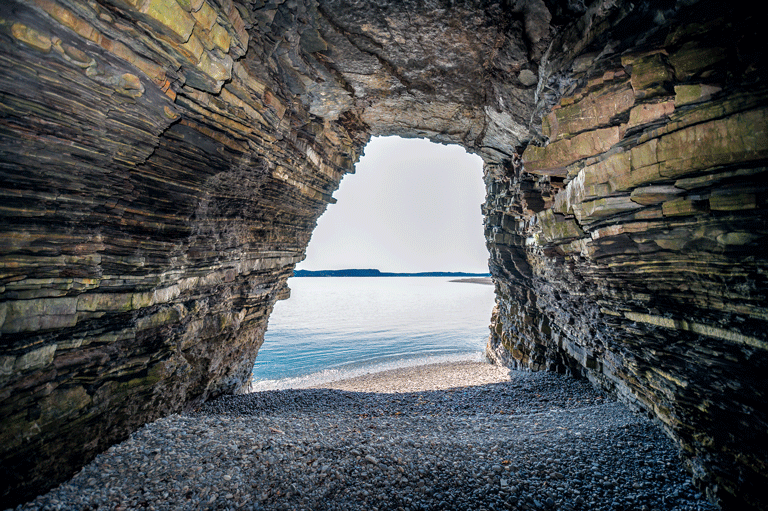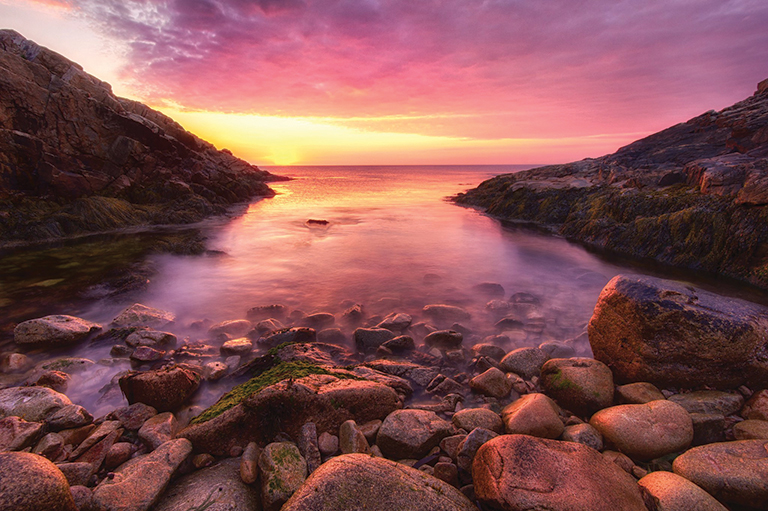Bell Island, Canada’s X-Files Isle
-
 The stratified rock walls of Swallow's Hole cave on Bell Island.Paul Kinsman
The stratified rock walls of Swallow's Hole cave on Bell Island.Paul Kinsman -
 A depiction of miner Billy Parsons adorns a building's wall in Wabana, Newfoundland and Labrador — one of several murals found on Bell Island.Something Saturday's Blog
A depiction of miner Billy Parsons adorns a building's wall in Wabana, Newfoundland and Labrador — one of several murals found on Bell Island.Something Saturday's Blog -
 A sunset as viewed from Bell Island.Lorentise Cranswick Butt
A sunset as viewed from Bell Island.Lorentise Cranswick Butt -
 Wildflowers gathered from a field near Butler's Marsh.Melony Ward
Wildflowers gathered from a field near Butler's Marsh.Melony Ward -
 Local actors re-enact one of the many spooky stories featured in the Ghosts of Bell Island sunset walking tour.Courtesy of Chris Lackner
Local actors re-enact one of the many spooky stories featured in the Ghosts of Bell Island sunset walking tour.Courtesy of Chris Lackner
Newfoundland and Labrador’s Bell Island is rich in three commodities: iron ore, storytellers, and things that go bump in the night.
The thirty-four-square-kilometre windswept rock is home to just over three thousand inhabitants. Situated near St. John’s, the supposedly haunted isle is accessible only by ferry. Some locals claim it’s a place where the dead — and worse — mingle openly with the living.
“This is the most haunted island in North America,” said Henry Crane, chair of Tourism Bell Island, which offers a guided “Ghosts of Bell Island” sunset walking tour.
The gregarious sixty-three-year-old was born to tell tall tales. Yet even he seemed uneasy as we journeyed down Fire Road, near a community called Scotia No. 1. Folklore and superstition have marked this hair-raising stretch as home to everything from hideous fairies, to a vengeful female spirit, to ghostly miners. The isle’s unearthly denizens are a product of its history. The town of Wabana was once a bustling ironmining community, its population peaking at nearly sixteen thousand before the Second World War.
The blend of ethnicities, from Irish, English, and Scottish to German, Estonian, and Roma, created an otherworldly cocktail of legends and traditions.
Crane described it as a “modern Dodge City” filled with sailors, misfits, and stowaways, where Celtic fairy tradition mixed with the macabre.
“They brought their stories, and folklore, and who knows what else,” Crane said.
Over the years, myths and superstitions have become intertwined with real-life tragedies, such as two deadly German U-boat attacks in 1942 that sunk four cargo ships and killed sixty-five sailors.
Other events, such as the mysterious “Bell Island Boom” of 1978, sparked talk of extraterrestrial visitations. The permanent population has dwindled, especially since the 1966 closing of the local mine.
However, attractions such as the Bell Island Community Museum and underground mine tour, and the haunted sunset walking tour lure more than twelve thousand tourists here annually.
One of the highlights of the haunted tour involves Butler’s Marsh in West Mines. The boggy terrain is peppered with wildflowers — yellow, purple, and pink — and gnarled clusters of pine and cedar trees.
Legend has it that the marsh is home to fairies, but Bell Island’s malevolent breed bears no resemblance to Disney’s Tinker Bell. Typically described as two feet tall, male, and hideously deformed, these fairies are said to have attempted to lure humans into the marsh — sometimes never to return.
The notorious area inspired Newfoundland playwright Robert Chafe to write the play. “Bell Island is a wild place. It is to Newfoundland what Newfoundland is to Canada,” Chafe says. “Talking to [islanders] about their fairies is a very different experience. They’re mean … twisted, sinister creatures.”
Legends abound of fairies terrorizing homes and even abducting children, Crane said, and early settlers blamed them for mysterious deaths and ailments.
Those fears have been passed down to modern times: Crane said that, when he was a child, his grandmother would often make him carry bread, or a torn Bible page, in his pocket as protection against the creatures.
Other spectral inhabitants include phantom miners who purportedly haunt the tunnels of the No. 4 mine. The white crosses chalked onto the rocky tunnel walls are a grim reminder of underground dangers such as explosions or runaway carts.
Bonnie Spracklin, a tour guide for the miners museum, says miners etched the crosses as a way of honouring the fallen; at least 106 miners have died in the mines over the decades, and many mining families were touched by tragedy; Spracklin’s great-uncle was lost to a dynamite mishap.
Another eerie location on the island is a patch of farmland known as Dobbin’s Garden — home, supposedly, to the “Bell Island hag.” This legend dates back to the Second World War, when German U-boats attacked the island.
The story is that a group of German sailors had secretly landed on the island to resupply their U-boat with the help of local sympathizers.
An unfortunate woman came upon the scene and was dragged into the marsh and killed. Locals, fearing a fairy trick, ignored her cries for help, and her restless spirit is said to still plague the site. Witnesses have described what initially looks like a woman in white walking up from the marsh after sunset.
“As the thing gets closer, the colour starts to go gray, and then the thing falls to its knees and starts to crawl on all fours like a dog,” Crane says.
The creature’s “wormed-out face” and foul, sulphuric smell then knock out the unfortunate spectator. (The fact that no such woman has ever been reported as missing hasn’t dampened the enthusiasm for the story.)
The most recent mystery to beset the island occurred on April 2, 1978. On that otherwise calm day, a loud explosion caused damage to homes and electrical wiring, and created two small “perfectly square” craters in the ground, Crane said.
The unexplained phenomena fuelled a documentary and wild theories of a secret military test or cover-up. However, some have attributed it to a lightning superbolt.
Bell Island’s haunted walk could easily be a marathon. Crane has devoted years to gathering tales from aging residents because, he said, “this was a place of legends, and it’s a shame to let them die.”
But maybe some beliefs will linger on: Local teens recently told Crane about a misshapen figure they saw in the brush. And even skeptics keep a healthy distance from fabled areas such as Butler’s Marsh.
Visitors are welcome, but they may want to carry some bread in their pocket. Better safe than sorry.
Themes associated with this article
Advertisement
Help support history teachers across Canada!
By donating your unused Aeroplan points to Canada’s History Society, you help us provide teachers with crucial resources by offsetting the cost of running our education and awards programs.




